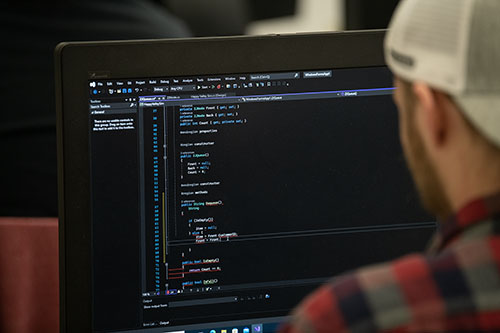How Computer Information Systems and Software Development Work Together to Power Our World
Published on: December 30, 2022

Think about a camera.
A security camera to be precise.
And not just any old camera mounted on the wall and recording to CCTV. No, consider a truly top-of-the-line security camera, one with high-powered lenses that allow it to zoom in and out and capture people and events in incredible detail. Moreover, imagine it's programmed to run special facial recognition software, identifying important individuals and then transmitting video of them to cloud servers hundreds of miles away, where it's stored until a security technician or investigator downloads the footage and analyzes it.
It sounds high-tech. It is high-tech. But this theoretical security camera also represents an important melding of two distinct but interconnected technology fields: computer information systems (CIS) and software development.
Indeed, this intersection between hardware and software animates and powers almost every aspect of our lives today. But before we get into how these fields come together and what that means for you and your future, let's take a minute to define each.
So, what are computer information systems?
Computer information systems, or CIS for short, encompasses all the elements that make up a network's infrastructure. This includes hardware, such as a computer or smartphone, and its connection to other systems or the internet. It can even encompass a network's connection to the cloud. In our security camera example, it's the camera and the connection to the cloud server.
In short, CIS is the foundation upon which any number of different programs, functions and applications can be built and executed.
What is software development?
Software development, on the other hand, is focused on programs, functions and applications. The program on your computer, the app on your phone, it's all software. With our security camera, it's the programs and code that allow it to analyze and identify faces and then send that information to relevant parties.
How CIS and software development power our lives
When CIS and software development come together, the possibilities are endless. Indeed, the intersection between hardware and software animates and powers almost every aspect of our lives today. The security camera we discussed above is just one example.
Think about your smartphone. It's essentially a small but exceptionally sophisticated computer information system, running a wide range of software in the form of apps to accomplish a wide range of tasks.
Do you have a smart TV? That's another example. How about a PlayStation? That's a computer information system running a wide range of software. A smartwatch like an Apple Watch or Fitbit? That's another example.
And these are just a few obvious examples. With the development of the Internet of Things (IoT), even more things we interact with in our daily lives will essentially become computer information systems running software.
Connecting with the Internet of Things
The Internet of Things essentially refers to a network of physical objects outfitted with sensors, software, and wi-fi or Bluetooth connective technology. While it's still a relatively new area and concept, it's been gaining significance and many businesses see it as a key element in the future.
Some IoT products are already fairly common. Take, for example, smart thermostat systems. Unlike traditional thermostats which must be adjusted by engaging the controls in a home or office, a smart thermostat is typically outfitted with wi-fi. A homeowner can then use their phone to adjust the temperature in their house or apartment when they aren't there, helping to reduce costs and increase convenience.
Another big idea that's becoming more common is a smart refrigerator. In this case, a refrigerator connected to the Internet might use sensors to note that you are getting low on milk. The refrigerator will then, depending on programming, either send you an alert about the low milk or if it's connected to a retailer, it could even just go ahead and order more.
It's undeniable: IoT-connected products will soon play a role in almost every aspect of our lives (yes, even in the bathroom).
Begin your career in information systems or software development at Husson
As IoT-connected devices and other computer information systems take on greater significance, there will be more and more opportunities for talented people who can create and program these devices. System administrators, engineers, IT professionals: all these jobs and more are part of the CIS field. Meanwhile, software developers and coders are in constant high demand.
Even better, there are many options within all of these career fields. Whether you want to work overseeing information technology infrastructure for a large company or you prefer to work for yourself developing new apps, you can almost certainly find a career path that meets your passions and preferred work style.
You can get started on this path at Husson University's School of Technology and Innovation. In our Computer Information Systems program, you'll get hands-on learning to build and maintain computers and networks. Meanwhile, in our Software Development program, you'll learn the fundamentals of coding and build a foundation of knowledge that will allow you to master any coding language.
Regardless of which path you choose, you'll be well prepared for an in-demand career servicing the technology that is revolutionizing how we live. Ready to get started building the future? Request more info or apply online today!
Back to All Articles
